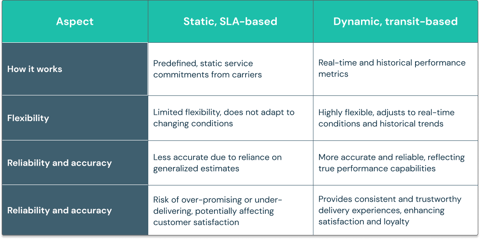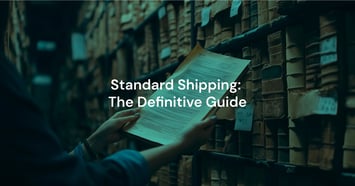Profitable Delivery Promises Using Transit Data | Shipium

Most digital customer experience leaders already know that offering a competitive delivery promise is a proven way to increase cart conversion and average order value (AOV).
But — it’s critical that your shipping operations teams can keep your promise at a reasonable cost for the business. Too often, digital experience teams and shipping ops teams are disconnected, especially when it comes to the sharing of important data that can inform a more accurate delivery promise.
A key (and often overlooked) aspect of making a delivery promise is understanding the carriers and service methods that your ops team is able to leverage — and not just the SLAs that each service method offers.
While delivery promises based on static criteria like carrier SLAs are better than nothing, the best delivery promises account for much more than that. In this blog, we’ll explore how you can work with your shipping ops team to leverage relevant carrier data to make more informed delivery promises that don’t compromise your margins.
Limitations of static delivery promises
If you’re basing your delivery promises on static criteria like carrier SLAs or exclusively on historical performance for predefined routes, you’re leaving accuracy and value on the table.
When delivery promises aren’t truly data-driven, you risk one of two outcomes:
- Missing a delivery date, which negatively impacts customer experience and brand perception.
- Meeting a date by upgrading to premium service methods or making similar concessions that increase costs and/or involve manual intervention.
For instance — many shipments that have date constraints tied to them don’t flow through economy service methods, because those methods don’t guarantee a delivery date. In many instances, they may actually meet your date constraint — but without the right data leverage, you’d never think to select them.
In reality, time-in-transit is impacted by a number of factors including seasonal variations in demand, weather patterns, fuel prices and more. With the right technology, you can factor these criteria into your delivery promise and close the data gap between your digital and shipping teams — allowing you to meet your dates at the lowest possible cost.
Let’s explore what a truly data-driven delivery promise looks like.
How to make more accurate delivery promises with transit data
To make a dynamic delivery promise, you need to account for all the relevant data that exists within your company’s systems of record (ecommerce platform, OMS, WMS, & TMS), as well as the macro-conditional data described above.
Here are the most important factors to consider.
Fixed Network Criteria
These are properties specific to your network that only change when you make changes to them. Think origins/nodes, operating days and times, carrier pickup schedules, and customizable shipment options (e.g., excluding air modes, setting cost-based limits). Once declared, these properties will influence the additional, more dynamic layers of the model.
Dynamic, Real-Time Factors
These are the broader conditions that we touched on in the prior section. Factors include the time of day, day of the week, seasonal variations, and broader macro-conditions like unexpected weather events, fluctuations in fuel prices, or labor issues. While it may seem obvious that these types of factors influence transit performance, they’re not considered nearly as often as they should be.
Predictive Factors
As mentioned above, you’ll need the right shipping technology (whether built in-house or bought) that enables you to generate ML-powered insights using your existing data. These involve insights such as projected demand increases during specific periods, trends in shipping volumes to particular ZIP codes, and…
Historical transit data
It’s important to go beyond SLAs to understand the true performance trends for each carrier and service method that you’re using. Knowing how carriers perform under different conditions (ex. different geographies) and how well their provided SLAs align with true performance is essential. When you weigh transit performance correctly, you can establish your own dynamic carrier SLAs with confidence — even for service methods that may not have them. For instance, while economy service methods aren’t tied to SLAs, they’re usually reliable enough to meet delivery dates for significantly more shipments than they’re used for.
The goal here isn’t just to offer more accurate delivery promises to improve the customer experience — generating a more accurate understanding of what your shipping network is capable of also helps your operations teams execute in a way that maintains (or in many cases, lowers) your organization’s shipping costs.
The benefits of a transit data-powered delivery promise
Let’s explore both the operational and business benefits of delivery promises based on dynamic time-in-transit data.
Operational benefits
The operational benefits here include:
- Improved promise accuracy: Dynamic modeling using transit data, network properties and macro-conditions provides more accurate time-in-transit predictions, leading to better resource allocation, process design, and scheduling.
- Enhanced flexibility: Real-time adjustments based on current network conditions (like traffic, weather, or service disruptions) allow for responsive logistics management processes that can adapt to unplanned events and still deliver for customers.
- Optimal route planning: Leveraging detailed network properties (ex. known origins) and specific carrier performance insights can help to identify the most efficient routes to send deliveries through, reducing both transit times and fuel consumption.
- Improved inventory management: Dynamic time-in-transit modeling also enables your operations teams to better allocate inventory throughout your network (ex. stores, warehouses, distribution centers etc.) reducing overstock and stockouts.
It’s also worth mentioning that, taken together, these benefits help to reduce friction between digital customer experience and shipping operations teams.
Overall business benefits
Data-backed delivery promises can impact your business in the following ways:
- Increased customer satisfaction: Accurate and reliable delivery promises enhance customer trust and satisfaction by ensuring that they receive their orders when expected. This positively impacts customer retention and LTV.
- Competitive advantage: Offering more precise delivery estimates can differentiate your brand from direct competitors and alternatives by attracting more customers who prioritize reliable delivery (hint: most of them do.)
- Cost savings: Improved process efficiency and reduced delays translate to cost savings across transportation, labor, and inventory management. Establishing your own, more accurate understanding of carrier performance also gives you negotiation leverage when it comes time to work out new contracts.
- Better resource utilization: Dynamic time-in-transit modeling ensures the best use of key resources including delivery trucks, warehouse space, and personnel.
Wrapping up
Offering delivery promises rather than estimated date ranges is quickly becoming a “table-stakes” strategy in the world of ecommerce. But in order to do this in a way that doesn’t unnecessarily increase shipping costs or create operational inefficiencies, you need to invest in advanced analytics capabilities that can help you establish more accurate and trustworthy SLAs based on network properties, real-time factors, and most importantly, historical transit data.

By doing so, you and your shipping ops teams can help your brand better meet customer expectations while simultaneously improving your financial performance.

Anurag leads Shipium’s product marketing efforts, focused on helping the world understand how our platform adds incredible value for everyone.


